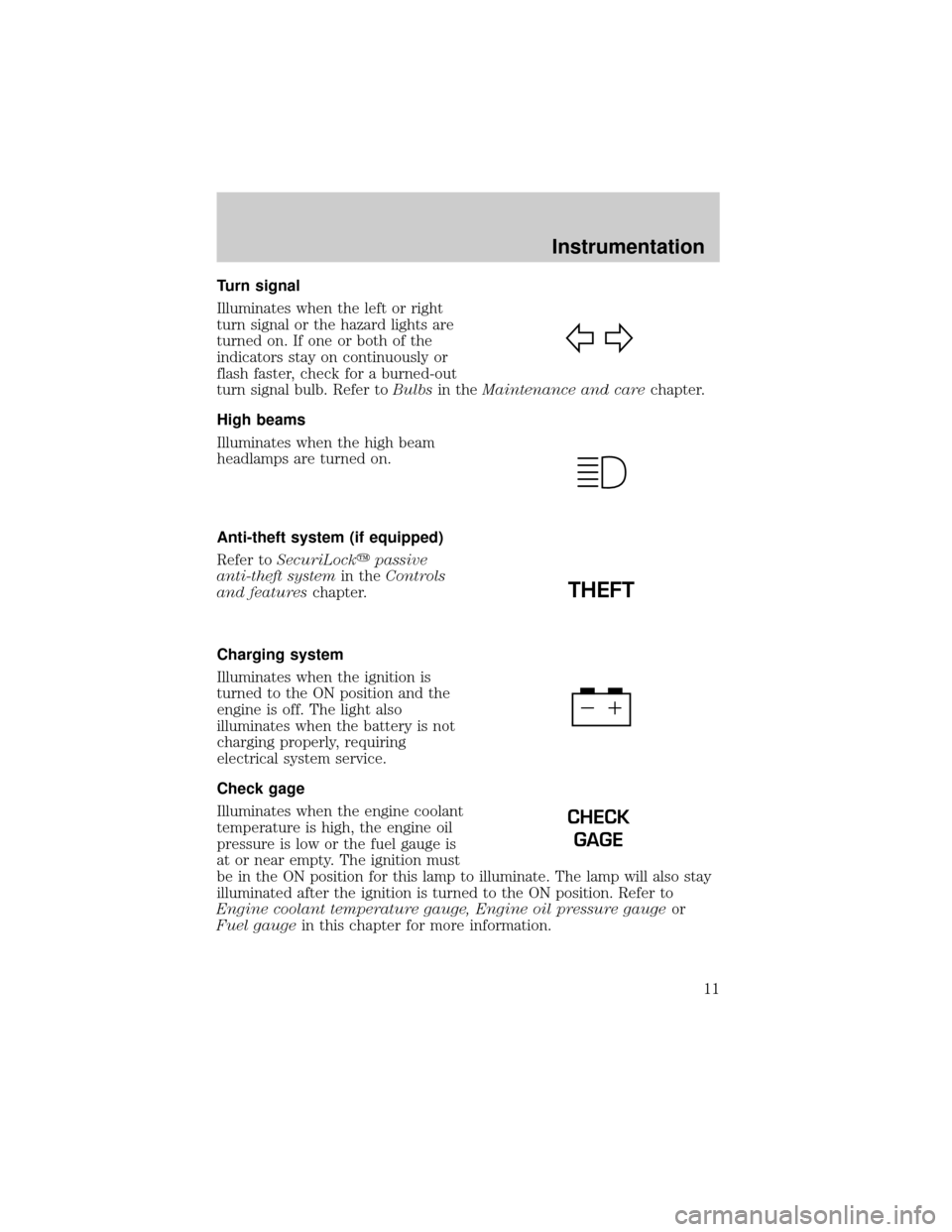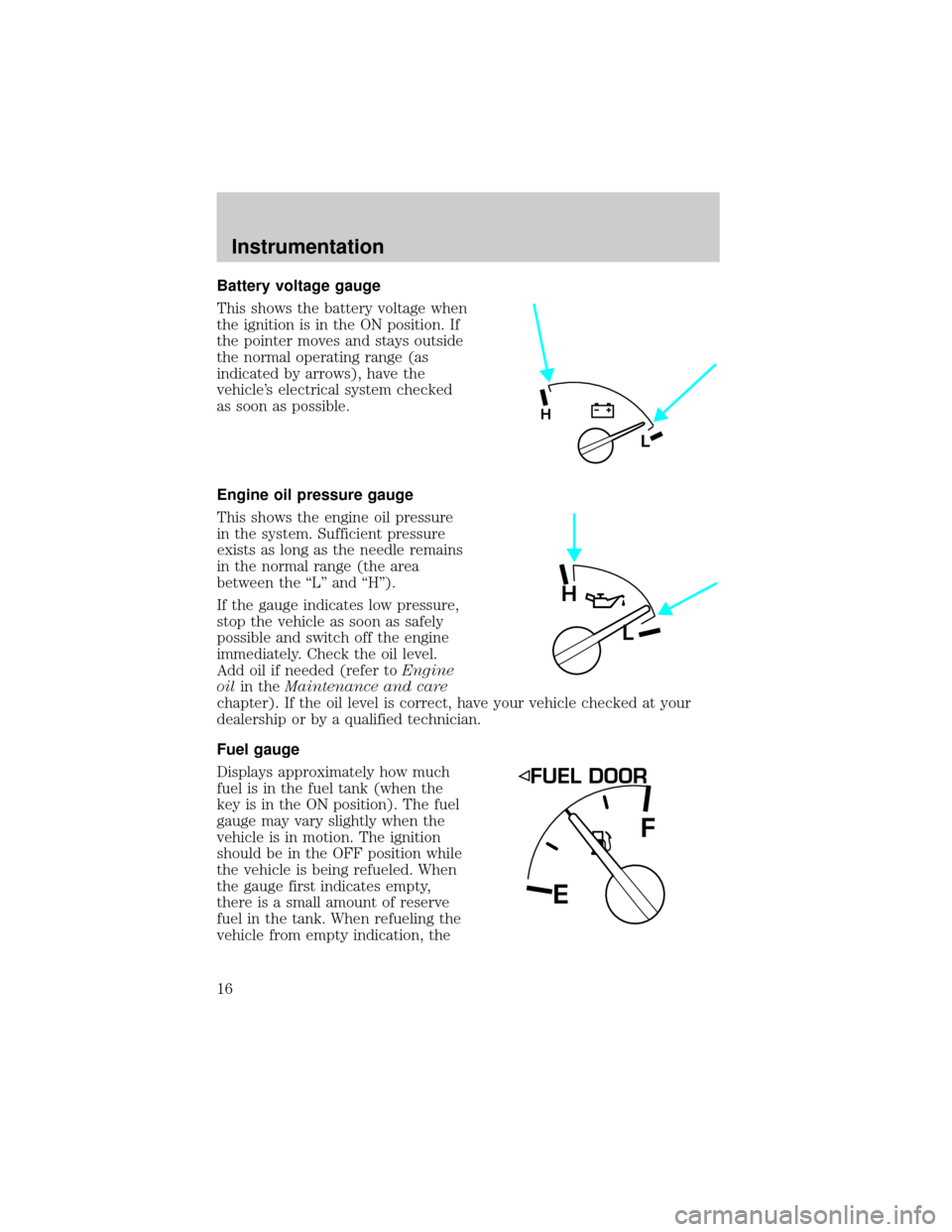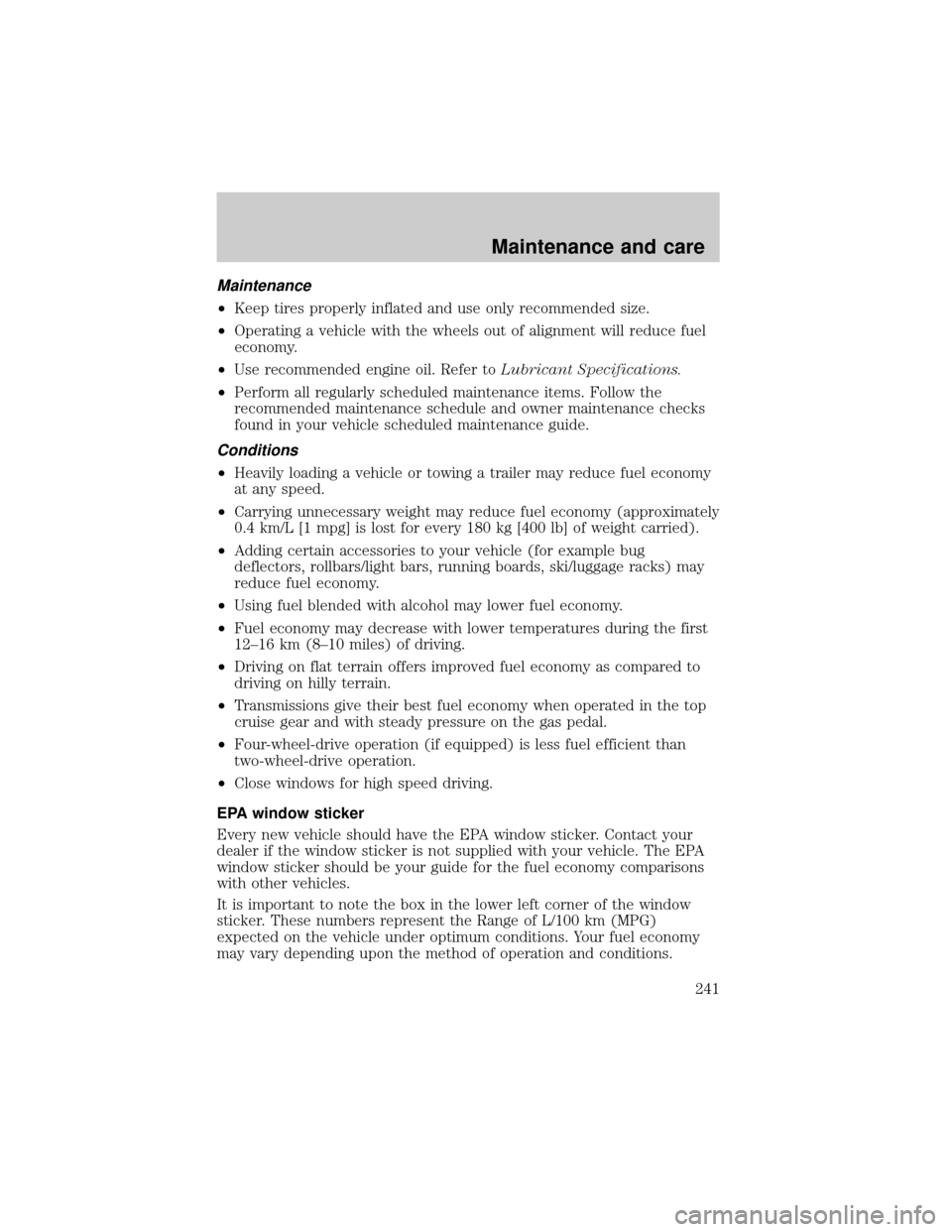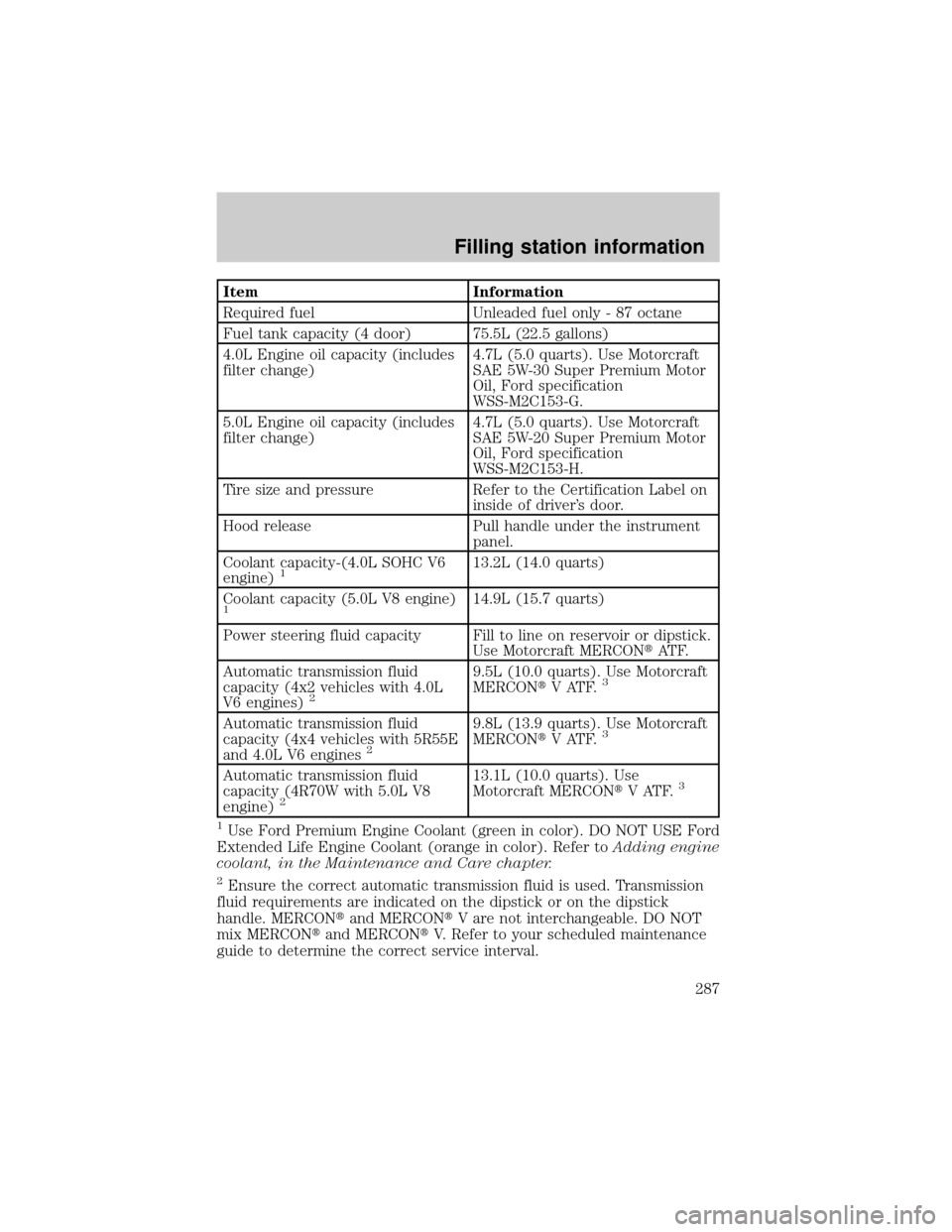2001 FORD EXPLORER oil pressure
[x] Cancel search: oil pressurePage 11 of 288

Turn signal
Illuminates when the left or right
turn signal or the hazard lights are
turned on. If one or both of the
indicators stay on continuously or
flash faster, check for a burned-out
turn signal bulb. Refer toBulbsin theMaintenance and carechapter.
High beams
Illuminates when the high beam
headlamps are turned on.
Anti-theft system (if equipped)
Refer toSecuriLockypassive
anti-theft systemin theControls
and featureschapter.
Charging system
Illuminates when the ignition is
turned to the ON position and the
engine is off. The light also
illuminates when the battery is not
charging properly, requiring
electrical system service.
Check gage
Illuminates when the engine coolant
temperature is high, the engine oil
pressure is low or the fuel gauge is
at or near empty. The ignition must
be in the ON position for this lamp to illuminate. The lamp will also stay
illuminated after the ignition is turned to the ON position. Refer to
Engine coolant temperature gauge, Engine oil pressure gaugeor
Fuel gaugein this chapter for more information.
THEFT
CHECK
GAGE
Instrumentation
11
Page 16 of 288

Battery voltage gauge
This shows the battery voltage when
the ignition is in the ON position. If
the pointer moves and stays outside
the normal operating range (as
indicated by arrows), have the
vehicle's electrical system checked
as soon as possible.
Engine oil pressure gauge
This shows the engine oil pressure
in the system. Sufficient pressure
exists as long as the needle remains
in the normal range (the area
between the ªLº and ªHº).
If the gauge indicates low pressure,
stop the vehicle as soon as safely
possible and switch off the engine
immediately. Check the oil level.
Add oil if needed (refer toEngine
oilin theMaintenance and care
chapter). If the oil level is correct, have your vehicle checked at your
dealership or by a qualified technician.
Fuel gauge
Displays approximately how much
fuel is in the fuel tank (when the
key is in the ON position). The fuel
gauge may vary slightly when the
vehicle is in motion. The ignition
should be in the OFF position while
the vehicle is being refueled. When
the gauge first indicates empty,
there is a small amount of reserve
fuel in the tank. When refueling the
vehicle from empty indication, the
L
H
H
L
EF
Instrumentation
16
Page 241 of 288

Maintenance
²Keep tires properly inflated and use only recommended size.
²Operating a vehicle with the wheels out of alignment will reduce fuel
economy.
²Use recommended engine oil. Refer toLubricant Specifications.
²Perform all regularly scheduled maintenance items. Follow the
recommended maintenance schedule and owner maintenance checks
found in your vehicle scheduled maintenance guide.
Conditions
²Heavily loading a vehicle or towing a trailer may reduce fuel economy
at any speed.
²Carrying unnecessary weight may reduce fuel economy (approximately
0.4 km/L [1 mpg] is lost for every 180 kg [400 lb] of weight carried).
²Adding certain accessories to your vehicle (for example bug
deflectors, rollbars/light bars, running boards, ski/luggage racks) may
reduce fuel economy.
²Using fuel blended with alcohol may lower fuel economy.
²Fuel economy may decrease with lower temperatures during the first
12±16 km (8±10 miles) of driving.
²Driving on flat terrain offers improved fuel economy as compared to
driving on hilly terrain.
²Transmissions give their best fuel economy when operated in the top
cruise gear and with steady pressure on the gas pedal.
²Four-wheel-drive operation (if equipped) is less fuel efficient than
two-wheel-drive operation.
²Close windows for high speed driving.
EPA window sticker
Every new vehicle should have the EPA window sticker. Contact your
dealer if the window sticker is not supplied with your vehicle. The EPA
window sticker should be your guide for the fuel economy comparisons
with other vehicles.
It is important to note the box in the lower left corner of the window
sticker. These numbers represent the Range of L/100 km (MPG)
expected on the vehicle under optimum conditions. Your fuel economy
may vary depending upon the method of operation and conditions.
Maintenance and care
241
Page 278 of 288

E
Emergencies, roadside
jump-starting ..........................199
Emission control system ..........242
Engine ........................................260
check engine/service engine
soon light ....................................8
cleaning ...................................250
coolant .....................................216
idle speed control ...................225
lubrication
specifications ..................258, 260
refill capacities ........................255
service points ..................209±210
starting after a collision .........186
Engine block heater .................154
Engine oil ..................................210
checking and adding ..............210
dipstick ....................................210
filter, specifications ........213, 255
recommendations ...................213
refill capacities ........................255
specifications ..................258, 260
Exhaust fumes ..........................155
F
Floor mats .................................107
Fluid capacities .........................255
Foglamps .....................................22
Four-Wheel Drive vehicles...12, 167
control trac .......................34, 168
description ......................168±169
driving off road ...............170, 173
electronic shift ..........................34
preparing to drive your
vehicle .....................................161Fuel ............................................234
calculating fuel economy...18, 238
cap .......................................9, 237
capacity ...................................255
choosing the right fuel ...........236
comparisons with EPA fuel
economy estimates .................241
detergent in fuel .....................237
filling your vehicle with
fuel ...........................234, 237, 239
filter, specifications ........238, 255
fuel pump shut-off switch .....186
gauge .........................................16
improving fuel economy ........238
octane rating ...................236, 260
quality ......................................236
running out of fuel .................237
safety information relating to
automotive fuels .....................234
Fuses ..................................187, 189
G
Garage door opener ..............92, 96
Gas cap (see Fuel cap) ........9, 237
Gas mileage (see Fuel
economy) ...................................238
Gauges .........................................13
battery voltage gauge ...............16
engine coolant temperature
gauge .........................................14
engine oil pressure gauge ........16
fuel gauge ..................................16
odometer ...................................15
speedometer .............................14
tachometer ................................15
trip odometer ............................15
GAWR (Gross Axle Weight
Rating) .......................................176
calculating ...............................178
Index
278
Page 287 of 288

Item Information
Required fuel Unleaded fuel only - 87 octane
Fuel tank capacity (4 door) 75.5L (22.5 gallons)
4.0L Engine oil capacity (includes
filter change)4.7L (5.0 quarts). Use Motorcraft
SAE 5W-30 Super Premium Motor
Oil, Ford specification
WSS-M2C153-G.
5.0L Engine oil capacity (includes
filter change)4.7L (5.0 quarts). Use Motorcraft
SAE 5W-20 Super Premium Motor
Oil, Ford specification
WSS-M2C153-H.
Tire size and pressure Refer to the Certification Label on
inside of driver's door.
Hood release Pull handle under the instrument
panel.
Coolant capacity-(4.0L SOHC V6
engine)
113.2L (14.0 quarts)
Coolant capacity (5.0L V8 engine)
114.9L (15.7 quarts)
Power steering fluid capacity Fill to line on reservoir or dipstick.
Use Motorcraft MERCONtAT F.
Automatic transmission fluid
capacity (4x2 vehicles with 4.0L
V6 engines)
2
9.5L (10.0 quarts). Use Motorcraft
MERCONtV ATF.3
Automatic transmission fluid
capacity (4x4 vehicles with 5R55E
and 4.0L V6 engines
2
9.8L (13.9 quarts). Use Motorcraft
MERCONtV ATF.3
Automatic transmission fluid
capacity (4R70W with 5.0L V8
engine)
2
13.1L (10.0 quarts). Use
Motorcraft MERCONtV ATF.3
1
Use Ford Premium Engine Coolant (green in color). DO NOT USE Ford
Extended Life Engine Coolant (orange in color). Refer toAdding engine
coolant, in the Maintenance and Care chapter.
2Ensure the correct automatic transmission fluid is used. Transmission
fluid requirements are indicated on the dipstick or on the dipstick
handle. MERCONtand MERCONtV are not interchangeable. DO NOT
mix MERCONtand MERCONtV. Refer to your scheduled maintenance
guide to determine the correct service interval.
Filling station information
287